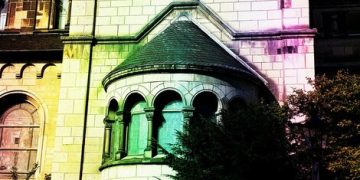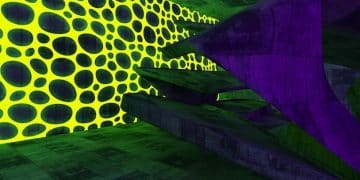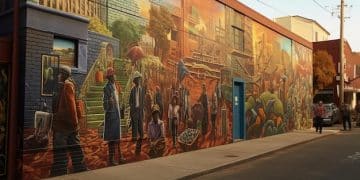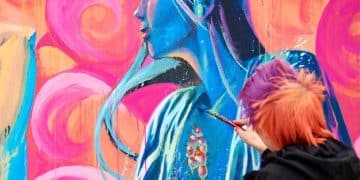Graffiti Art & Tech: Augmented Reality in US Murals
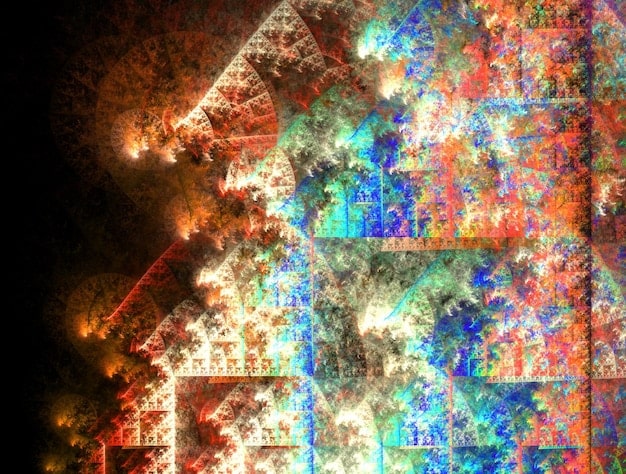
The integration of augmented reality (AR) into US murals is revolutionizing graffiti art, transforming static urban canvases into dynamic, interactive experiences that bridge physical and digital realms, fostering new forms of expression and public engagement.
The urban landscape has long served as a canvas for expression, with murals telling stories, sparking dialogue, and beautifying public spaces. Yet, what if these static works of art could transcend their physical limitations, offering layers of hidden meaning and interactive experiences? This is precisely what the convergence of Graffiti Art and Technology: Exploring the Use of Augmented Reality in US Murals is achieving, ushering in a new era of artistic innovation across the United States.
the evolution of graffiti art: from trains to digital screens
Graffiti art, once synonymous with subway cars and clandestine expressions, has undergone a profound transformation. From its raw, rebellious roots, it has ascended to gallery walls and public art installations, earning recognition as a legitimate and powerful art form. This journey is not just about changing perceptions; it also reflects a continuous embrace of new tools and techniques that push the boundaries of artistic creation.
Historically, graffiti’s essence lay in its immediacy and accessibility, a direct conversation with the urban environment. The techniques were often rudimentary, relying on aerosol cans, markers, and shared knowledge passed down through generations of artists. The focus was on intricate lettering, vibrant colors, and thematic imagery that often reflected social commentary or personal identity within communities.
technology’s early influence on urban art
While augmented reality might seem like a quantum leap, technology has always subtly influenced urban art. Photography, for instance, allowed artists to capture and share their work beyond its physical location, creating archives and inspiring new generations. Digital design tools, subsequently, enabled artists to plan complex pieces with greater precision before ever touching a wall.
Projection mapping : Before AR, some artists experimented with projecting images onto surfaces, temporarily transforming buildings with light and animation.Digital sketching : Artists use tablets and software to conceptualize intricate designs, refining their ideas before execution.Online communities : Platforms dedicated to urban art foster global connections, allowing artists to learn from one another and showcase their work.
The shift from purely physical creations to works that incorporate digital elements represents a natural progression. It’s an acknowledgment that art, like technology, is dynamic, constantly seeking new avenues for expression. This readiness to adapt has paved the way for more sophisticated integrations, such as augmented reality, inviting viewers to experience murals in ways previously unimaginable.
The contemporary urban artist is no longer confined by the fixed dimensions of a wall. Their canvas extends into the digital realm, offering boundless possibilities for interaction and narrative expansion. This evolution isn’t about abandoning traditional methods but rather enhancing them, adding layers that resonate with a digitally fluent audience.
augmented reality: bridging the physical and digital canvas
Augmented reality (AR) is not science fiction; it is a tangible technology that overlays digital information onto the real world. Unlike virtual reality (VR), which creates entirely immersive digital environments, AR enhances our perception of reality by adding computer-generated elements to what we see. For muralists, this translates into an ability to add dynamic, interactive, or narrative layers to their static paintings.
The beauty of AR in art lies in its seamless integration. Viewers typically use a smartphone or tablet camera to look at a mural, and the AR application then projects digital content onto their screen, appearing as if it’s part of the physical artwork. This can range from subtle animations complementing the existing design to fully interactive stories that unfold as the viewer moves or taps their device.
how ar transforms murals
AR technology leverages markers, image recognition, or location data to detect the physical mural and activate the corresponding digital content. This digital content can encompass a wide range of media, from 2D animations and 3D models to soundscapes and embedded narratives. The transformative potential is immense:
Dynamic storytelling : Static images can spring to life with animated characters, moving objects, or evolving landscapes, adding depth to the artist’s message.Interactive engagement : Viewers can interact with elements of the mural, triggering animations, sound effects, or even accessing additional information about the artwork or artist.Layered meanings : Artists can embed hidden messages or alternative narratives that are only revealed through the AR lens, creating a scavenger hunt for deeper understanding.
The process often begins with the artist creating their traditional mural. Once the physical artwork is complete, they then design the digital overlay using specialized AR software. This involves either mapping digital assets precisely onto specific features of the mural (image recognition) or linking the AR experience to a general geographic location (GPS-based AR), allowing more abstract interaction around the artwork.
The fusion of physical paint and digital pixels creates a novel viewing experience that encourages repeat engagement and active participation rather than passive observation. For artists, AR offers an expansion of their creative toolkit, providing new avenues for expression and for connecting with audiences in a technologically advanced world.
pioneering ar murals in us cities: case studies
Across the United States, forward-thinking artists and organizations are already embedding augmented reality into urban murals, creating a new wave of public art that challenges traditional boundaries. These pioneering projects serve as compelling examples of how AR can elevate the mural experience, inviting viewers into an expanded world of art.
philadelphia: the city of murals embraces ar
Philadelphia, renowned as “The City of Murals,” has been at the forefront of integrating technology into its extensive public art collection. Mural Arts Philadelphia, a leading organization, has explored AR to add new dimensions to existing works. One notable project allowed viewers to scan murals to unlock audio narratives from the artists themselves, offering insights into their creative process and the stories behind their art.
This initiative not only enriched the viewer’s immediate experience but also deepened their understanding of the social and historical contexts in which these murals were created. It transformed passive viewing into an immersive, educational journey, highlighting the power of AR to convey nuanced information that a static image cannot.
los angeles: vibrant narratives brought to life
In Los Angeles, a city synonymous with artistic innovation, several projects have emerged that leverage AR to spectacular effect. Artists are using AR to animate characters within a mural, make abstract shapes pulsate with energy, or even introduce virtual elements that appear to interact with the real-world environment surrounding the artwork.
“Visions in Motion” : A series of murals in downtown LA where street art comes alive with animated sequences and soundscapes, activated via a dedicated app.Community-centric narratives : Some artists use AR to bring community stories to life, featuring interviews with locals or historical footage overlayed onto murals depicting neighborhood heritage.Ephemeral art : AR allows for the creation of temporary digital art installations that don’t permanently alter the physical space but offer unique, fleeting experiences for viewers.
These examples from Philadelphia and Los Angeles demonstrate a crucial aspect of AR in murals: its versatility. It can be used for educational purposes, to enhance storytelling, or simply to add a layer of whimsy and wonder. The key is that the AR experience is purposefully designed to complement, rather than detract from, the physical artwork.
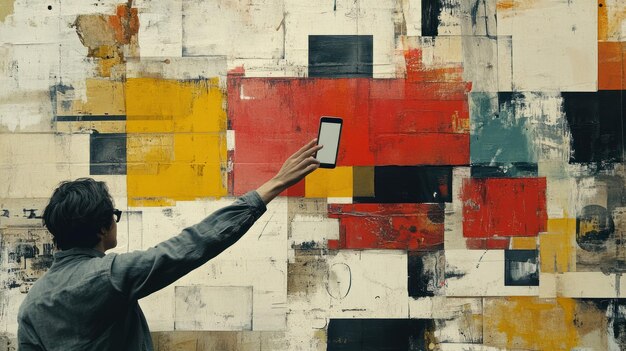
The success of these early projects fosters a growing interest among artists and urban planners alike. As the technology becomes more accessible and intuitive, the possibilities for AR murals will undoubtedly continue to expand, turning more US cities into living, breathing galleries where art transcends the visible spectrum.
technical challenges and creative solutions for ar murals
While augmented reality offers exciting new possibilities for muralists, its implementation is not without its technical hurdles. From precise registration to user experience, artists and developers face specific challenges when translating their vision into a functional AR experience on public walls. Overcoming these requires both technical acumen and creative problem-solving.
One primary challenge is the accuracy of tracking. For AR content to appear seamlessly integrated with a physical mural, the AR application must accurately “understand” the mural’s position and orientation in real-time. Environmental factors like lighting changes, weather conditions, or even graffiti applying over portions of the original artwork can interfere with the image recognition needed for stable AR overlays.
main technical obstacles
Lighting variations : Murals are exposed to changing sunlight, shadows, and artificial night lighting, which can affect how image recognition algorithms identify the artwork.Surface irregularities : Rough textures, fading paint, or physical damage on a wall can make it difficult for AR technology to consistently track the mural.Device compatibility : Ensuring that the AR experience functions smoothly across a wide range of smartphone models and operating systems can be complex.Downloadable content : For rich AR experiences, users might need to download specific apps or significant data, which can be a barrier for some.
Artists and developers are employing various strategies to mitigate these issues. For lighting, some AR apps incorporate adaptive algorithms that adjust to different light conditions. Others design the AR content to be less dependent on pixel-perfect tracking, focusing more on broader interactive zones or storytelling that doesn’t require absolute precision.
innovative solutions in practice
To address issues of surface irregularity and potential future alterations to a mural, some projects use location-based AR rather than image recognition alone. By anchoring the AR content to GPS coordinates, the digital overlay is less sensitive to minor changes on the physical surface. Another solution involves embedding discreet QR codes or custom markers within the mural itself, which are easier for AR apps to recognize consistently.
Regarding user accessibility, artists are exploring web-based AR (WebAR), which allows users to experience AR content directly through their mobile browser without needing to download a separate app. This significantly lowers the barrier to entry and promotes wider engagement. Furthermore, collaboration between artists and AR developers is crucial, ensuring that creative vision aligns with practical technological capabilities.
Solving these technical challenges paves the way for more robust and widely accessible AR mural experiences, ultimately enriching public spaces and providing artists with a powerful new medium for expression. The ongoing innovation in this space promises to make AR murals an increasingly common and captivating feature of urban landscapes across the US.
the impact of ar on urban aesthetics and public engagement
The integration of augmented reality into US murals is not merely a technological novelty; it profoundly impacts urban aesthetics and transforms how the public engages with art in shared spaces. By adding digital layers to physical artworks, AR creates a multi-dimensional artistic experience that challenges conventional notions of public art and fosters deeper interaction.
A primary impact on urban aesthetics is the new sense of dynamism AR brings to static surfaces. Where murals once offered a fixed visual, AR allows them to become fluid, evolving canvases capable of presenting different narratives, animations, or interactive elements based on individual engagement. This can revitalize overlooked walls and breathe new life into existing artworks, ensuring their continued relevance and appeal.
enhancing public engagement
Augmented reality transforms passive viewing into an active, immersive experience. Instead of simply walking past a mural, viewers are encouraged to pull out their phones, scan the artwork, and explore hidden dimensions. This act of discovery makes the art personal and participatory, fostering a deeper connection:
Interactive storytelling : AR can turn a mural into a narrative journey, inviting viewers to unlock chapters of a story, learn about historical events, or discover community voices.Educational components : Information about the artist, the art movement, or the social context of the mural can be embedded within the AR experience, offering educational insights.Community participation : Some AR murals even allow viewers to contribute, adding their own virtual messages or elements to a collective digital layer, encouraging a sense of co-creation.
This increased engagement can lead to a greater appreciation for public art and urban spaces. When art is interactive and surprising, it becomes a destination rather than just a backdrop. It sparks conversations, encourages exploration, and can even drive foot traffic to certain areas, benefiting local businesses and promoting cultural tourism.
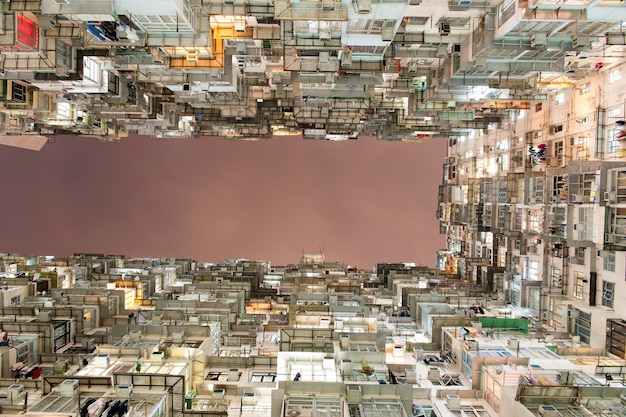
Furthermore, AR murals can offer new avenues for artistic expression, allowing artists to incorporate ephemeral or complex concepts that would be impossible to render in paint alone. This pushes the boundaries of creativity and positions urban art at the forefront of technological innovation, making cities more vibrant and culturally rich.
The introduction of AR effectively broadens the audience for urban art, attracting technologically fluent younger generations while offering a fresh perspective for traditional art enthusiasts. It represents a significant step towards creating smart cities where art, technology, and community converge to create unique and enriching urban experiences.
future prospects: the evolution of ar graffiti and urban landscapes
The trajectory of augmented reality in graffiti art suggests a future where urban landscapes become infinitely dynamic and interactive canvases. As AR technology continues to mature and become more accessible, its integration into murals is poised to evolve beyond simple animations to create truly immersive and context-aware public art experiences. The potential for transforming cities into living galleries is immense, and artists are only just beginning to tap into this new frontier.
One significant prospect lies in the increasing sophistication of AR tracking and rendering. As devices become more powerful and software more refined, AR overlays will appear even more seamlessly integrated into the physical world, blurring the lines between what is painted and what is projected. This will allow for hyper-realistic animations, detailed 3D models, and intricate interactive elements that react intelligently to the viewer’s movement and environment.
personalized and responsive art
Imagine murals that adapt to the time of day, displaying different content during daylight hours versus night, or artworks that respond to local weather conditions. Future AR murals could even be personalized, offering different narratives or visual elements based on the individual viewer’s preferences or past interactions. This level of customization would make each encounter with the art unique and deeply personal.
Contextual storytelling : AR could pull real-time data to inform the mural’s digital layer, such as local news headlines or environmental data, making the art highly relevant to the immediate moment.Multi-user experiences : Future AR platforms could enable multiple viewers to interact with the same mural simultaneously, seeing each other’s digital actions and participating in shared experiences.Ephemeral digital art : The rise of temporary and location-specific digital art could gain traction, allowing artists to create fleeting AR installations without permanent physical imprints.
Beyond individual artworks, AR has the potential to weave entire urban districts into cohesive narrative experiences. Imagine walking through a neighborhood where a series of murals, when activated by AR, tell a continuous story, creating an open-air museum without walls. This would create immersive cultural pathways and unique tourist attractions.
Furthermore, the collaboration between artists, technologists, urban planners, and local communities will be crucial. Grants and funding for “smart art” initiatives will likely increase, fostering an ecosystem where innovation thrives. The ongoing evolution of AR will not only redefine graffiti art but also reshape how we perceive and interact with our shared urban environments, turning every street corner into a potential portal to augmented imagination and creativity.
ethical considerations and accessibility in ar art
As augmented reality transforms urban art, it also brings forward important ethical considerations and questions of accessibility. While the technology promises exciting new artistic frontiers, it is crucial to address how AR murals might impact public space, digital inclusion, and the very nature of art consumption. Responsible development and deployment are key to ensuring that AR art truly enriches, rather than complicates, our shared environments.
One core ethical question revolves around the digital overlay’s permanence and control. Who owns the digital space above a physical mural? What happens if AR content is misused or manipulated post-creation? There is a need for clear guidelines and potentially new legal frameworks to protect artists’ digital rights and prevent unauthorized alterations of their AR work. Ensuring the longevity and integrity of the digital content linked to physical murals is also a concern, as apps and platforms can become obsolete.
ensuring accessibility and digital inclusion
While AR offers new ways to experience art, it inherently requires access to specific technology—a smartphone or tablet—and an internet connection. This raises questions about digital equity. How can AR murals be made accessible to those who may not own the latest devices or have reliable access to data? Art in public spaces should ideally be enjoyed by everyone, regardless of their technological proficiency or economic status.
Public access points : Cities could explore providing public-access tablets or designated Wi-Fi hotspots near AR murals for broader engagement.Inclusive design : Developers should prioritize user-friendly interfaces in AR apps, making them intuitive for diverse age groups and technological comfort levels.Hybrid experiences : Artists can ensure that the physical mural itself remains a powerful standalone piece, with AR acting as an enhancement rather than a prerequisite for appreciation.
Another consideration is the potential for screen dependency. While AR encourages interaction with physical spaces, it still relies on people looking through a screen. Striking a balance between the digital layer and direct engagement with the physical art and its surroundings is vital to avoid fostering a culture where people experience the world primarily through their devices.
Furthermore, data privacy for users interacting with AR apps is a growing concern. Artists and developers must be transparent about what data is collected and how it is used. Addressing these ethical and accessibility challenges proactively will be essential for AR murals to truly serve as a democratic and inclusive art form within the public realm, ultimately fulfilling their potential as enriching additions to urban life.
| Key Point | Brief Description |
|---|---|
| 🎨 Evolution of Art | Graffiti art’s journey from raw expression to recognized art form, embracing new technologies like digital design. |
| 📱 AR Integration | Augmented reality overlays digital content onto physical murals, creating dynamic, interactive experiences. |
| 🛠️ Tech Challenges | Overcoming issues like lighting, surface texture, and device compatibility through innovative solutions like WebAR. |
| 🤝 Public Impact | AR murals enhance urban aesthetics and foster deeper public engagement through interactive storytelling and education. |
frequently asked questions about AR murals
▼
Augmented reality in graffiti murals refers to the technology that overlays digital information, such as animations, 3D models, or sounds, onto a real-world physical mural when viewed through a smartphone or tablet camera. It enhances the static artwork with dynamic, interactive elements, creating a multi-layered experience for the viewer without altering the original physical art.
▼
AR murals typically work through dedicated mobile applications. Users point their device’s camera at a mural, and the app uses image recognition or GPS data to identify the artwork. Once recognized, the app projects pre-designed digital content onto the live camera feed, making it appear as part of the physical mural on the device’s screen. This content can be interactive or respond to user gestures.
▼
Integrating AR offers numerous benefits, including enhancing storytelling by animating static scenes, providing interactive engagement for viewers, and embedding educational content about the art or artist. It transforms passive observation into an immersive experience, attracting wider audiences, revitalizing urban spaces, and offering artists new avenues for creative expression beyond physical limitations.
▼
Yes, challenges exist. Technical hurdles include ensuring accurate and consistent AR tracking despite varying lighting conditions or physical changes to the mural. There are also concerns about device compatibility, the need for apps (though WebAR is addressing this), and the ethical aspects of digital content ownership and long-term accessibility. Ensuring digital equity among viewers is also a key challenge.
▼
The future for AR in urban art is promising, with expectations for more sophisticated tracking, personalized and responsive content, and multi-user interactive experiences. It could lead to entire urban districts transforming into integrated narrative experiences, with temporary digital installations and greater collaboration between artists, technologists, and urban planners. AR will increasingly redefine our interaction with public spaces.
conclusion
The convergence of augmented reality and graffiti art signifies a pivotal shift in how we conceive, create, and experience public art across the United States. From the static canvases of yesteryear to today’s dynamic, interactive urban narratives, AR is injecting a new dimension into murals, inviting deeper engagement and fostering a unique blend of physical presence and digital wonder. While challenges in accessibility and technology integration persist, the innovative spirit of artists and developers continues to push boundaries, promising a future where our cities become infinitely responsive, richly layered artistic landscapes. This evolution redefines not just art, but our very interaction with the urban fabric, proving that the street remains one of the most vibrant and adaptable galleries for human expression.
